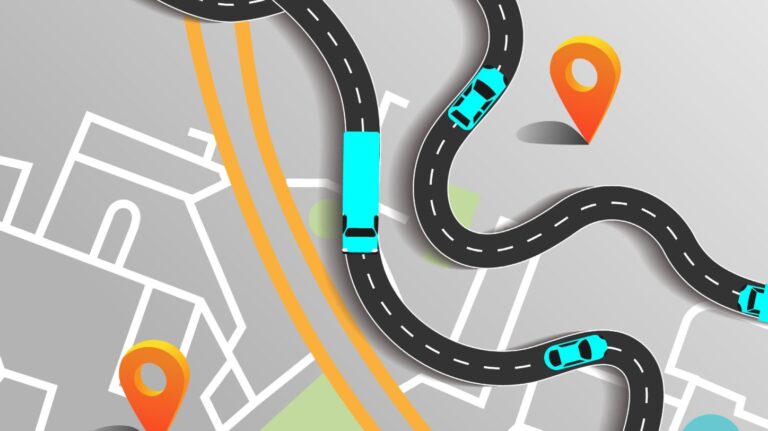CiTTi Magazine gathers insights to explore how data, technology, and collaboration are driving greener last-mile deliveries amid growing urban freight and e-commerce pressures.
With UK e-commerce sales forecast to exceed £150bn in 2025, according to Statista, urban freight networks face mounting pressure to cut carbon emissions and ease congestion. Last-mile deliveries – responsible for up to 41% of supply chain costs, according to Capgemini Research Institute, and nearly 30% of urban transport emissions, according to the International Transport Forum – are under scrutiny as cities expand clean air zones (CAZs) and roll out low emission zones (LEZs).
In 2025, the landscape for sustainable urban logistics is evolving rapidly. Industry efforts are reshaping how goods move through our cities: electric vans now account for nearly 8% of new van sales, according to the Society of Motor Manufacturers and Traders, cargo bikes could replace up to 17% of urban van deliveries by 2030 says Transport for London, and data-driven fleet management tools are becoming essential. Yet significant challenges persist – from infrastructure gaps and rising operational costs to the delicate balance of maintaining delivery speed while meeting environmental objectives.
To get to the heart of these issues, CiTTi Magazine gathered a panel of industry experts for a deep-dive discussion: Fabian Seithel, associate vice president of EMEA sales at global telematics provider Geotab; Serhat Kyuchuk-Pakyuz, founder and CEO of sustainable last-mile delivery specialist Ridelogix; and Ben Whitby, UK operations director at Staci UK, a provider of outsourced logistics solutions. Together, they discuss the roadblocks, innovations, and outlook for eco-friendly last-mile logistics.
What are the biggest barriers to decarbonising the last mile in UK cities, and how are logistics operators working to overcome them?
Fabian Seithel: The last mile is notorious for being the most complex and costly part of the logistics chain, and decarbonising it presents a real challenge. Fleet operators face steep upfront costs for electric vehicles (EVs), and the UK’s charging infrastructure, though expanding, remains inconsistent – particularly outside major cities. Additionally, managing a mixed fleet of internal combustion engine (ICE) vehicles and EVs complicates operations.
But decarbonisation is achievable with the right data-driven strategies. Fleets leveraging telematics insights can identify which ICE vehicles can be replaced without compromising operational efficiency. It’s about targeting the lowest-hanging fruit first – vehicles on shorter, predictable routes. This ensures a faster return on investment. In our experience, most fleets start to see significant savings within three to five years, not only from reduced fuel and maintenance costs but also from improved operational efficiency.
We’ve seen first-hand how powerful data can be. Take Milk & More, for example – they’ve saved more than £2m annually by optimising energy consumption and driver behaviour. Predictive maintenance also plays a critical role here, enabling fleets to prevent breakdowns and extend vehicle lifespans. It’s not just about cutting emissions – it’s about ensuring operational resilience.
Serhat Kyuchuk-Pakyuz: The numbers speak volumes – van traffic has doubled in two decades, and emissions have climbed 60% since 1990. Green Alliance data shows that transitioning just 7.5% of deliveries from diesel vans to e-cargo bikes could slash more carbon than scrapping all domestic flights in the UK. Yet the barriers remain significant: patchy infrastructure, inconsistent regulations between regions, and the high cost of facilitating fleet transitions.
For smaller operators such as us, the shift is often easier – we’re nimble, and our operations are built around e-cargo bikes. However, scaling remains a major challenge for the wider industry. The UK government needs to offer more targeted incentives, and collaboration between operators, policymakers, and infrastructure providers must become the norm.

Ben Whitby: Infrastructure is the key word here. Demand for EVs and cargo bikes is outpacing the infrastructure roll-out, which leaves many operators in a bind. Add to that vehicle limitations – lower payload capacities and range constraints – and you’ve got a situation where meeting delivery volumes requires more personnel and more vehicles. That’s not sustainable from a labour or cost perspective, especially with recruitment challenges across the sector. Strategic partnerships and hyperlocal depot networks are the way forward.
How do customer expectations around delivery speed and convenience balance with environmental objectives?
Seithel: Data-driven route optimisation helps fleets deliver both speed and sustainability. Our analysis of over four million connected vehicles shows that trip volumes surge by around 11% during peak seasons, which can ramp up congestion and emissions. Fleets using our platform manage these surges while keeping emissions 18.5% lower than non-users. The key is precision – choosing the right routes and vehicles at the right times, supported by real-time insights.
Kyuchuk-Pakyuz: In the B2B space, we’re now seeing a shift toward scheduled same-day transfers rather than on-demand deliveries. This allows for smarter route planning and fewer unnecessary trips. Communication with customers is crucial – when they understand the benefits of sustainable options, they’re often happy to choose them. Some providers, including us, are even sharing environmental impact metrics with clients, helping them see the tangible benefits of their delivery choices.
Whitby: While demand for fast, cheap delivery remains strong, there’s growing interest in greener options. However, many consumers still prioritise speed and cost. The challenge is to make sustainable delivery the default, not the premium choice. Carbon-neutral delivery options are gaining traction, but wider adoption will take time. Brands need to be transparent about the impact of delivery choices to encourage behavioural shifts.
How are urban consolidation centres and micro-hubs helping to reduce delivery-related congestion and emissions in dense urban environments?

Seithel: Micro-hubs and consolidation centres can fundamentally transform last-mile operations. By staging goods closer to customers, fleets reduce journey lengths, emissions, and reliance on large vehicles. Our telematics data reveals how much volumes surge during peak periods like Black Friday – without micro-hubs, managing those spikes becomes a logistical nightmare. These hubs also allow for the deployment of smaller, cleaner vehicles like electric light commercial vehicles or cargo bikes for the final stretch.
Kyuchuk-Pakyuz: I’ve seen first-hand how micro-hubs work during my time at Amazon. In London, for example, we rolled out micromobility hubs using e-cargo bikes, significantly reducing van traffic and emissions. At Ridelogix, we’re building on that model by helping retailers repurpose their physical stores into smart fulfilment hubs. This unlocks new service models – offering faster, same-day deliveries while reducing congestion and environmental impact.
Whitby: Micro-hubs are pivotal. The reduced range of EVs makes it impractical to deliver from central depots over longer distances. Localised hubs enable final-mile delivery with smaller, greener vehicles. They also align with alternative delivery methods like lockers or pick-up/drop-off points, removing the need for some deliveries entirely. But space constraints and planning regulations remain a barrier. Policy support is essential for scaling these hubs.
How can local authorities better support sustainable last-mile logistics?
Seithel: Councils have a pivotal role in shaping the regulatory and infrastructural environment. CAZs and EV incentives are steps in the right direction, but fleet operators often face a patchwork of regulations across cities. Unified policies across major hubs like London, Manchester, and Birmingham would accelerate adoption.

Kyuchuk-Pakyuz: The planning system itself needs reform. Setting up micro-hubs can be unnecessarily complex and bureaucratic. Streamlining planning permissions, offering grants, and simplifying regulation would remove barriers. More funding schemes, like those supporting e-cargo bike adoption, would also make a difference. Additionally, kerbside access remains overlooked – designated loading bays for zero-emissions vehicles would offer real benefits.
Whitby: Workforce development is another area local authorities could improve. The logistics sector faces an ageing workforce, and attracting younger talent requires education and training programmes. Investment in apprenticeships and graduate schemes would help make the sector more appealing and sustainable long term.
What kinds of data do logistics providers need to operate sustainably in congested cities – and who should be responsible for aggregating and providing it?
Seithel: Fleets need real-time data on vehicle performance, energy consumption, emissions, and charging infrastructure. Our telematics platform offers predictive maintenance insights, allowing operators to prevent breakdowns and optimise fleet health – contributing directly to sustainability. Milk & More’s £2m savings came not just from operational tweaks but from smarter maintenance schedules. Broader data integration across municipal platforms would allow for more informed policymaking.
Kyuchuk-Pakyuz: It’s not just vehicle data – we also need real-time traffic conditions, LEZ boundaries, parking availability and roadworks. Aggregating this through public-private partnerships would significantly improve urban logistics. Effectively, everyone would be working from the same playbook.
Whitby: Open data platforms, jointly managed by local authorities and private stakeholders, are key. This includes traffic flow data for optimisation, EV charger availability, and air quality metrics – all critical for agile, sustainable logistics.
What is your outlook for hydrogen, biomethane, and other alternative fuels in the UK’s last-mile logistics mix?
Seithel: Hydrogen and biomethane have potential, particularly for heavier vehicles on regional routes, but electrification leads urban logistics. We’re seeing trials of hydrogen-fuelled vehicles in mid-mile operations across Europe, such as the H2Haul project, launched in 2019, which is deploying hydrogen-powered trucks in Belgium, France, Germany, and Switzerland to test the viability of hydrogen in freight transport. However, urban applications remain limited for now due to infrastructure constraints and cost considerations.
Kyuchuk-Pakyuz: Battery EVs are the most practical for dense cities. Hydrogen could fit middle-mile logistics, but for now, it’s about deploying cost-effective solutions – cargo bikes and electric vans are scalable and ready today.
Whitby: We’ve trialled low-carbon fuels such as hydrotreated vegetable oil in regional operations, with some success. Biomethane also shows promise for heavier vehicles. But urban logistics remains firmly in the electrification camp for the time being—faster to deploy, easier to scale. Infrastructure investment will dictate how quickly alternative fuels can grow their share.
This article was originally published in the May 2025 issue of CiTTi Magazine.
Achievements and innovations in urban logistics will be recognised and celebrated at the fourth annual CiTTi Awards on 25 November 2025 at De Vere Grand Connaught Rooms in London. Visit www.cittiawards.co.uk to learn more about this unmissable event for the UK’s transportation sector!





